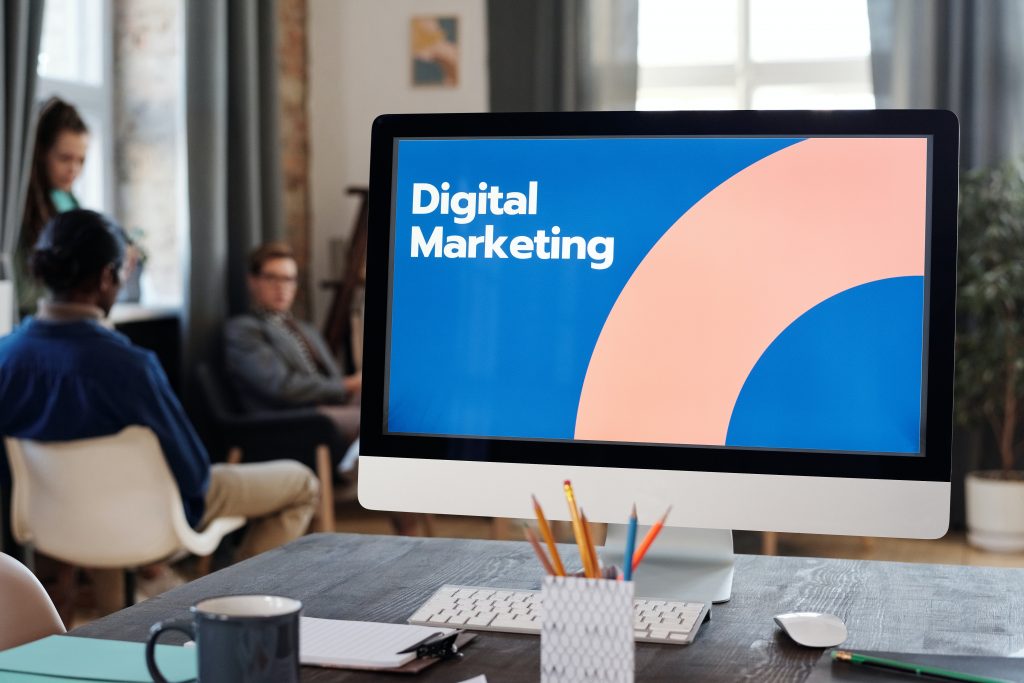What Is Digital Marketing? [The Ultimate Online Marketing Guide]

If you are wondering “What is digital marketing” well it is the use of technology and the Internet to deliver marketing messages to current and prospective customers. It encompasses a range of strategies and tactics used to generate leads, build brand awareness, and generate sales. Digital marketing is the strategy you use to manage your digital presence and build your digital reputation. It involves using digital channels such as email, websites, social media, and search to build and manage your online brand.
Digital marketing is different from traditional marketing in that it uses digital channels such as the internet to drive business and consumer traffic, sales, and leads. It’s a strategic approach used to build a brand and generate leads and revenue. Online marketing has become a key part of many businesses marketing strategies and is an important part of any digital strategy.
Defining What Is Digital Marketing For Content Creators And Brands
Having a solid definition of “What is digital marketing” can be a mixed bag for content creators and brands. But keep in mind the simplicity of the definition: Digital marketing is a strategy used to build a brand and generate leads and revenue. It involves using digital channels such as the internet to drive business and consumer traffic, sales, and leads. It’s a strategic approach used to build a brand and generate traffic and sales.
It has become a key part of many businesses marketing strategies and is an important part of any digital strategy as we will discuss in this Ultimate Guide:
Digital Marketing Assets That Are Common
The Importance Of Digital Marketing Can Sometimes Be Understated
What Is The Purpose Of A Digital Marketer?
10 Types of Digital Marketing To Grow Your Business
Planning, Implementing And Optimizing Digital Marketing
Outbound Marketing vs Inbound Marketing: Which Is Better?
Some Effective Digital Marketing Strategies Your Brand Must Know
Online Marketing Campaign Examples
Digital Marketing Assets That Are Common
What is digital marketing or at least the assets that accompany it? Below you will learn the different digital marketing assets and explore what a digital marketing asset is, what types of assets there are, and how to determine which ones will give you the best return on your investment.

You will also learn about common tasks every digital marketer must perform to ensure the longevity of their marketing plan.
We can use digital assets to tell our visual story, showcase our products and services, and even make a great first impression when a new visitor visits our site. Start with your branding statement, then tell your story through your digital marketing assets.
Website
Written content (blog posts, ebooks, whitepapers, etc.)
Branded materials (logos, colors, and icons)
Images (infographics and photos)
Social media accounts
Online Tools (interactive content and SAAS tools)
Reviews
Digital marketing assets help build brand awareness, authority, and an online presence, are cost-effective to produce, and have the ability to reach a far wider audience.
The Importance Of Online Marketing Can Be Understated
Online marketing is important for a variety of reasons (we commonly use the phrases “online and “digital” interchangeably). It helps build brand awareness, authority, and an online presence, is cost-effective to produce, it’s measurable, and has the ability to reach a far wider audience. It also helps build a reputation as a trusted brand, generate leads, convert those into sales, and build a loyal audience.

1. Build Brand Awareness
2. Build Authority and Reputation as a Trusted Brand
3. Strong Online Presence
4. Cost Effective To Produce Digital Marketing Content
5. Content Is Measurable And Trackable
6. Reach A Far Wider Audience
7. Generate Leads And Sales Conversions
8. Build A Loyal Audience For Your Brand And Business
The importance of online marketing can sometimes be understated. Online marketing is a critical part of any marketing strategy. It uses the internet to drive business and consumer traffic, sales, and leads. It’s a strategic approach used to build a brand and generate traffic and sales.
Though it’s sometimes understated as a part of a marketing strategy, it is just as important as any other traditional strategy.
1. Build Brand Awareness
In an increasingly digital world, the importance of building brand awareness can’t be understated. People are consuming more content and news online than ever before, which is increasing the reach of both companies and individuals, and helping brands connect with their audience on deeper levels.
When you build a brand awareness strategy, you create a foundation for building awareness and improving your brand’s overall visibility and a sense of ongoing presence.
Being able to build a larger brand awareness increases the likelihood that customers will share your content and increase the number of people who know who you are and what you do.
What are the benefits of digital marketing to build brand awareness? Communication is one of the most important parts of any successful marketing campaign. When a brand uses digital channels (such as social media, e-mail, and instant messaging), the goal is to connect and engage with consumers on a deeper level, and digital marketing strategies offer benefits that continue to increase in value as the years’ progress, such as improved brand awareness and increased customer satisfaction.
2. Build Authority and Reputation as a Trusted Brand
Building a brand authority and reputation as a trusted brand is another important factor that digital marketing can understate. When you build brand authority and reputation online, the goal is to build a digital platform that allows your current and potential customers to connect and engage with your brand on a deeper level. This allows you to increase your brand awareness and connect with consumers with higher brand loyalty.
Also you demonstrate that you have the expertise to solve your customers’ problems and deliver on your promises. This increases the likelihood that customers will share your content and increase the number of people who know who you are and what you do. Digital marketing is a critical part of any online marketing strategy.
3. Strong Online Presence
As digital marketing continues to grow and evolve, so does the importance of a strong online presence. A well-crafted online presence can help you build your personal brand, connect with consumers on an emotionally-charged level, and foster relationships with your customers.
The importance of a strong online presence can’t be understated. In an increasingly digital world, the majority of consumers are consuming content and news online, which is increasing the reach of both companies and individuals, and helping brands connect with their audience on a deeper level.
When you build a strong online presence, the goal is to build a digital platform that allows your current and potential customers to connect and interact with your brand on a deeper level. This allows you to increase your brand awareness and connect with consumers with higher brand loyalty.
4. Cost Effective To Produce Digital Marketing Content
Increasingly, brands are investing in digital marketing in order to reach consumers on a deeper emotional level. The best way to accomplish this is to create content that informs and educates consumers while also supporting your brand goals and providing value.
The cost-effectiveness of producing the content you need, when you need it. In the digital marketing world, producing sales-ready content that converts visitors into customers is an essential step to building a successful business and generating profits.
5. Content Is Measurable And Trackable
Content is the lifeblood of any online marketing activity, so it’s absolutely essential that your content is measurable and trackable. This is particularly true when you’re paying for your content, as you want to make sure that you’re getting your money’s worth.
Digital marketing content is measurable when you use specific and actionable metrics to measure the success of your content. This allows you to identify which content is generating the most leads and sales, which content is generating the highest levels of engagement, and which content is generating the highest levels of interaction with your brand.
When you use measurable and trackable content, the goal is to build a digital platform that allows your current and potential customers to connect and interact with your brand on a deeper level. This allows you to increase your brand awareness and connect with consumers with higher brand loyalty.
The best way to evaluate the amount of content that you’re producing is to measure the amount of traffic and leads that your content is generating. This allows you to identify which content is generating the most results and drives, and which pieces could use some adjustments to increase the number of visitors that your content is driving to your website.
A great way to measure the amount of traffic your content is generating is to use a content analytics platform such as Google Analytics, which allows you to track both the quantity and quality of the content that users are reading on your website. A way to measure the number of leads that your content is generating is to use a content marketing platform such as HubSpot, etc.
6. Reach A Far Wider Audience
There is a far greater reach with digital marketing than there is with traditional advertising. With digital marketing, your message can be delivered to a very wide audience, which means more chances of reaching high-quality and high-converting customers.
Content creators and brands are turning to digital marketing to connect and interact with their audiences on a deeper level than traditional methods. Digital marketing allows them to connect with their audiences in a more personal way and reach them at scale.
7. Generate Leads And Sales Conversions
The ultimate goal of digital marketing is to generate leads and sales conversions. The importance of digital marketing in generating leads and sales conversions is evident when you consider the impact that digital marketing has on the bottom line. The best digital marketing platforms allow you to generate leads and sales conversions with little-to-no effort on your part. This allows you to generate significant amounts of leads with minimal time and effort on your part.
The goal of digital marketing is to generate leads and sales conversions. The best way to generate leads is to create content that educates and informs consumers, while also supporting your brand goals and providing value. When you create content that is measurable and trackable, the goal is to build a digital platform that allows your current and potential customers to connect and interact with your brand on a deeper level. Your content often generates a high level of interaction, which in turn drives a high level of leads and sales.
The bottom line is that the future of digital marketing is all about the customer. Digital marketing has unlimited potential to expand your business and grow your bottom line, but to do so, you need to use it smartly. It is not enough to throw money at it. You need to spend your time creating great content that is educational and engaging so that your leads and customers are ready to convert and buy.
8. Build A Loyal Audience For Your Brand And Business
It is common for newer brands to focus on their most important asset, their brand story. The brand story is how the brand envisions itself, what it stands for, and how it plans to connect with its audience. It’s the foundation of your brand identity.
You have to remember that your audience is consuming this content because they feel there is value in it for them. They are being “sold” on your product or service, which means that they have to believe they are getting value out of what they are being told, and more importantly, that they will receive value in the future. So, you have to make sure you are constantly creating new content that is valuable first and foremost to your audience, and also valuable to you in terms of your brand.
What Is The Purpose Of A Digital Marketer?
The purpose of a digital marketer is to build a platform that connects and interacts with your audience on a deeper level than traditional methods. Digital marketers are the professionals that are responsible for creating, implementing, and optimizing digital marketing strategies and campaigns. The primary role of a digital marketer is to build a digital platform that enables your content to connect and interact with your audience on a deeper level. Over time, this will generate a high level of awareness and leads for your brand and business.

The role of a digital marketer is to generate brand awareness and ultimately generate leads and sales. The best digital marketers are the ones who are able to drive brand awareness and generate leads and sales for their clients. This is accomplished by creating content that educates and informs consumers, while also supporting your brand goals and providing value. When you create content that is measurable and trackable, the goal is to build a digital platform that allows your current and potential customers to connect and interact with your brand on a deeper level.
How Digital Marketers Measure Key Performance Indicators (KPIs)
The best way to do this is to focus on your key performance indicators (KPIs), which are the metrics that are used to measure the effectiveness of your channel. If you want to understand the performance of your digital marketing efforts, the first step is to identify your key performance indicators (KPIs). These are the metrics that you use to measure the success of digital marketing channels.
Here are a few examples of KPIs as it relates to digital marketers or even content creators:
Content Manager
KPI: Oversee the entire content marketing strategy and development for each channel
The content manager is responsible for the creation, implementation, and maintenance of written content for the brand. They ensure the consistency and quality of written content to ensure maximum brand impact while maintaining the brand’s voice in all written materials.
A content manager oversees the writing, editing, and updating of content. They have the primary responsibility for managing their piece of content, ensuring that the content is up to date, appropriate, and interesting.
A content manager utilizes a variety of social media channels to tell the story to a variety of audiences. They are also in charge of creating an online presence and managing a channel or site for the brand, service, or product.
Social Media Specialist
KPI: Day-to-day management of social media accounts
The job description of a social media specialist is to create a strategy that connects and interacts with your audience on a deeper level than traditional methods. A social media specialist is the person responsible for creating and implementing the social media strategy for the brand.
They are responsible for the development and management of social media channels, such as Facebook, Instagram, and YouTube. They are also responsible for the management of the social media accounts of the brand and the integration of the social media strategy into the day-to-day operations of the business.
SEO Assistant
KPI: Help to get higher rankings in the search engines
The job description of an SEO assistant is to create a strategy that increases the organic search rankings for the brand. An SEO assistant is a person in control of creating a strategy that increases the organic search rankings for the brand.
They are responsible for the development and management of the SEO strategy for the brand. They are also responsible for the development and management of the SEO content and channels such as Google and Bing for the brand.
Video And Podcast Editors
KPI: Put together the audio and video content for digital channels
A video and podcast editor is responsible for the creation, production, and maintenance of audio and visual elements used in media content. They take a story idea and help the creator tell their story with the proper audio and visual elements, such as music, voice-over, graphics, animation, or video editing.
The video and podcast editor is also in charge of creating, uploading, and managing video and audio content, such as snippets of interviews or educational videos. They may also produce, edit, or review the video or audio content and work on the video and audio production for multiple short and long-form videos.
PPC Advertising Manager
KPI: Manage PPC campaigns and create ads for relevant digital channels
The job description of a PPC advertising manager is to create a strategy that generates the highest ROI (return on investment) from the digital marketing ad spend. A PPC advertising manager is responsible for the development and management of the PPC (pay per click) advertising strategy for the brand.
They are responsible for the development and management of the PPC ad campaigns and the management of the PPC accounts of the brand. They also oversee the testing, optimization, and re-design of the PPC ads.
10 Types of Digital Marketing To Grow Your Business
1. Affiliate Marketing
2. Mobile Marketing
3. Email Marketing
4. Content Marketing
5. Social Media Marketing
6. Search Engine Optimization
7. Audio Marketing
8. Video Marketing
9. Paid Advertising Marketing
10. Virtual And Augmented Reality Marketing
Each digital marketing type has its own benefits and drawbacks, and it’s important to know which one is best for your business. Below you can learn what each digital marketing type can do for your business today and the best practices for each.

1. Affiliate Marketing
Affiliate marketing is a way to generate income by referring customers to merchants you have been engaged with or to the merchant’s website. In affiliate marketing, you sell a product or service using another person’s identity.
You set up a website, give it a unique URL or include links to the affiliate’s website on your website, and start promoting affiliate products on your site. When people buy goods from your affiliate link, you make a commission.
Affiliate marketing typically is not expensive to start, and you can get specific about which affiliate programs to promote. As an affiliate marketer, you can work with many affiliate programs at once without having a lot of extra work.
2. Mobile Marketing
Mobile marketing is the use of digital marketing channels such as mobile apps, mobile websites, and text messages to engage with customers. Mobile marketing is designed to help your customers when they are on the go, such as at a bus stop, in line at the grocery store, or while they are walking down the street.
When it comes to using mobile devices to connect with your audience, there are a number of ways to connect. You can use mobile marketing campaigns to spread awareness, but you can also go one step further with native advertising techniques that add a personal touch to your brand.
3. Email Marketing
The use of email to promote a business is called email marketing. It is used to keep in touch with customers and prospects, and to build relationships and convert customers. Email marketing is used by businesses of all sizes to deliver their message and build their brand, and for marketing purposes.
It usually uses promotional emails, text messages, or instant messages. Email is a popular communication tool among busy people and can encourage repeat visits to a website.
The vast majority of email sent to current and potential customers consists of advertising copy. Some marketers use email to send their latest communication in order to catch the reader’s attention. Others send an email to “dip” into a potential sale. In either case, the goal is the same: to get the attention of a specific audience and prompt them to take action.
4. Content Marketing
Content marketing is the strategic use of content to build and enhance brand awareness, increase the probability of customer purchases, and drive revenue. It also helps build an authentic connection with prospects. Broadly, content marketing consists of three major components: content generation, content distribution, and content consumption but has the potential to increase customer lifetime value.
When done well, content marketing can be one of the most powerful tools for growing a business. It lets your prospects know what you do and what you’re about while building your personal brand.
Helping content creators to make the best of content marketing is often complicated, especially for small businesses. Luckily, there are many ways to use content marketing to improve your revenue and increase your exposure.
5. Social Media Marketing
The use of social media channels such as social networks, social media platforms, and groups to build and expand your brand’s reach is called social media marketing. Social media marketing can be used to spread awareness, but it can also go one step further with native advertising techniques that add a personal touch to your brand.
The social media channels most commonly used for social media marketing include Facebook, Twitter, Instagram, LinkedIn, Tiktok, and YouTube. Social media channels can be used to build a community around your brand, and to promote your content, products, and services. Social media marketing is a dynamic and ever-changing channel, so it’s important to keep up with the latest trends and learn how to use the channels to your advantage.
6. Search Engine Optimization
The practice of optimizing a website so that it is attractive and improves its rankings on search engines is called SEO or Search Engine Optimization. SEO involves the manipulation of metadata to rank well on search engines, build links, and increase the visibility of a website.
SEO has three parts that you should know: On page, Off page and Technical.
On Page SEO
On Page SEO is the process of optimizing the content of your website to improve the ranking of your site in search engine results, and thus increase the number of visitors to your site. These techniques include making your page content more relevant, adding more relevant keywords, and ensuring your content is written with adequate keywords for the search engines to understand.
Off Page SEO
Off Page SEO is the practice of improving a website’s ranking in search engine results without changing the actual content of the website. In short, the practice of getting traffic from search engines by gaining links (the overall process is called link building).
Technical SEO
The third part is Technical SEO which is the process of optimizing web pages to ensure they load quickly and perform well on modern browsers. This involves ensuring the code of your website is well structured, designed to function on different devices, and optimized for the various search engines.
Technical SEO also involves developing a website that is mobile-friendly, which is important for search engine optimization. It is a complex field, and as such it’s often best to hire a professional to help you optimize your site.
7. Audio Marketing
Audio marketing is the practice of using sound to promote products or services. It is the practice of utilizing audio to help someone obtain a better understanding of a product or service, often in a short amount of time.
It can include music, music clips, spoken word, and sound effects. Audio can be used to promote a brand, explain a service, or give a voice to a particular community.
There are a number of benefits that come with using audio marketing, including that it’s easy to listen to, easy to share, and can be used with or without a website. It’s also proven to be an effective way of generating leads and building your brand.
8. Video Marketing
Video marketing is a method of targeted marketing through the use of videos. It is most often used for visual media, such as commercials, music videos, short films, and films, but it can be used for any media type. Often, the videos used are promotional or infomercials, although some are more educational and informative.
As a video marketer, you are responsible for driving customers to your brand and achieving the goal of generating leads. Video marketing is the use of videos to promote a specific brand, product or service. It can also be used to advertise a company’s ongoing campaigns, educational material, or announcements about newly launched products. Video content can include branded video, branded marketing content, and/or advertising.
9. Paid Advertising Marketing
Paid Advertising Marketing is a form of advertising that seeks to promote a product or service by paying to have its message displayed to a large number of people, usually through the use of paid search ads on search engines.
It is most often used to pay for ads that are displayed when a particular word or phrase is searched. In sponsored links, advertisers are still charged however the link is not accompanied by any text, which may draw less attention than the ads accompanied by text would, or the link in traditional text-based ads.
The pay-per-click (PPC) advertising method features paid ads that link to the landing page of your choosing, typically on search engines.
10. Virtual And Augmented Reality Marketing
Virtual and Augmented reality marketing is a marketing strategy that companies are now using to advertise their products or services. It is a highly interactive method, which involves the virtual insertion of product and service information into the physical world.
It’s a relatively new marketing technology and is very different from traditional advertising. Instead of merely being a push for your product, virtual and augmented reality marketing also provides a push for a brand or product.
Planning, Implementing, And Optimizing Digital Marketing
When you’ve decided on which digital marketing channels you want to use, you’ll need to plan out your launch. This involves researching the best platforms to use, developing a strategy for when your campaign launches and then executing your plan.

You’ll want to make sure you have someone on your team dedicated to the launch of your digital marketing campaign, so you can keep your focus on your core business. This will also give you time to build up your database and optimize your website for the new channels.
Step 1: Plan Out Your Launch
Before you can start advertising on your digital marketing channels, you’ll want to identify who your audience is and what platform will best reach them. You can use marketing analytics to identify which demographics are visiting your website and which channels are bringing them in.
Then, you can segment your audience by platform, to determine which platform will be best for reaching your audience on the channel. You may also want to look into other channels to see if they’re a better fit for your brand.
Step 2: Researching The Best Platforms
You’ll want to research the best platforms to use for your digital marketing campaign. The first thing you should do is determine which platforms are the best fit for your brand.
This involves research into the platform’s audience, what’s being discussed on the platform, and how your brand will be able to add value to the conversation. Then, you can set up your channels and begin putting out content and/or advertising on those channels.
Step 3: Develop A Strategy For When Your Campaign Launches
Setting up a strategy for when your digital marketing campaign launches will help you determine your goals and allow you to develop a measurement strategy. This will help you determine the impact your campaign has on your business and help you optimize your strategy from there.
You’ll want to establish your goals, such as the number of new customers you want to generate, and develop a measurement strategy, such as how many new website visitors you want to get. You can then use the data to optimize your campaign going forward.
Step 4: Executing Your Plan
While a digital marketing strategy is a critical part of a marketing campaign, it is also important to ensure that the plan is being optimized to ensure its success. Some of the things that you can consider when optimizing your plan include testing new ad formats, testing creative for maximum effectiveness, testing different ad copy, testing timing and length of ads, creating videos and landing pages that engage, and testing a different creative.
Execution of your digital marketing strategy begins with the launch and optimization of your digital channels. You’ll likely have multiple channels, including social media, display advertising, email blasts, and more. You can also consider investing in other channels, such as affiliate marketing or search engine optimization.
Outbound Marketing vs Inbound Marketing: Which Is Better?
Outbound marketing is the practice of sending out messages to target audiences rather than to everyone, in the hope of reaching a higher number of people. This method is usually used to generate leads but can also be used to inform people about the products, services, and companies they may not otherwise have had exposure to.

Outbound marketing provides many benefits. First, it provides the ability to target the right audience with the right message. Second, it provides the opportunity to build a relationship with the audience, which can result in increased brand loyalty and lifetime value.
Examples of outbound marketing include banners, ads on social media, and even email blasts.
Inbound Marketing is an approach to marketing that is focused on attracting users rather than trying to sell them. It is the process of acquiring visitors from a variety of sources, capturing their interest, and turning them into leads.
Inbound marketing is typically thought of as a means to drive traffic to your website. It refers to marketing channels such as search, social media, email, and ads on other websites that draw visitors to your site. Inbound marketing is frequently used in conjunction with outbound marketing channels to optimize the delivery of a message.
The intersection between brand discovery and brand loyalty occurs when a company implements an inbound marketing strategy. When a company focuses on building relationships with its customers, it builds a foundation of brand discovery.
Over time, this brand discovery evolves into a state of brand loyalty, which results in an increase in brand awareness and ultimately strengthens the relationship between the company and its customers.
Pros And Cons Of Outbound/Inbound Marketing
Outbound: limited or no human interaction.
Inbound: open, personal interaction.
Outbound marketing increases the chances that a prospect will be sold because the prospect believes that he or she has a better chance of being sold by a human.
Inbound marketing increases the chances that a prospect will be converted because the prospect believes that he or she needs help.
Which is The Best Outbound Or Inbound?
Both inbound and outbound marketing are equally important in the world of digital marketing. Each has a different focus, and both are equally critical to the growth of your company.
Outbound marketing focuses on the relationship between the brand and the customer and is the more traditional form of advertising. It’s less about pushing a message and more about creating a relationship with your customers, which is a far more difficult task.
Effective Digital Marketing Strategies Your Brand Must Know
Marketing Automation
Marketing automation is a process of automating digital marketing campaigns so that they can be run automatically without requiring human interaction. This allows brands to execute their digital marketing strategies on a daily basis without having to spend time and resources manually managing campaigns.

Most marketing automation platforms allow brands to create automated digital campaigns that can be triggered based on specific actions taken by visitors such as a specific page being visited or a certain amount of time spent on the website.
This means that digital marketing campaigns can be targeted at specific audiences and are more likely to be effective because they are more targeted than traditional advertising campaigns.
Instant Message Marketing
Instantly messaging your followers is one of the most effective ways to engage with the masses. In fact, almost 90% of social media conversations are happening via text or chat. In general, if your followers are online, they’re likely online for long stretches of time.
IM allows marketers to have instantaneous communication with their customers in a way that was not possible before with a text-only conversation or email. It also provides businesses with a quick way to connect with their customers and create a more personal connection.
User-Generated Content Marketing
User-generated content marketing is a form of marketing that focuses on content created by your customers or followers. The most effective user-generated content marketing strategies allow your customers to share their experiences with you with photos, videos, and other content on your website.
This provides a way for your customers to connect with your brand and helps build brand recognition. User-generated content marketing is also commonly referred to as user-generated advertising or user-generated marketing.
Personalization And Retargeting Marketing
Personalizing and retargeting marketing is a strategy where a company, brand, or product sends advertisements to people who have previously visited that company, brand, or product’s website.
It allows you to connect with users on a more personal level, which encourages them to keep coming back and is a great way to get your brand in front of new audiences.
Personalization and retargeting marketing build meaningful, long-lasting relationships with your audience and allow you to better reach them. As a result, it helps you create more meaningful connections with your customers and deliver more personalized experiences.
Online Marketing Campaign Examples
Tell A Story With An Emotional Trigger [Dove]
One of the most powerful and effective advertising campaigns ever launched is Dove’s campaign called “Real Beauty”. It highlights the importance of being real, rather than a candidate for beauty queen or model. It accomplished this by saying, “We believe no one should be denied the chance to create their own beauty.”
Emotional triggers are ways to connect to your audience with a strong story. They can be visual, audio, or written. They can be incorporated into any medium, such as videos, blogs, email, and more.
Dove has remained true to its brand values while communicating its connection to nature and empathy with society through its advertising campaigns.
Embracing New Technologies [Domino’s Pizza]
In 2006, Domino’s turned to digital marketing to promote its pizza to millennials. The objective was to increase brand awareness and obtain more sales. Domino’s Pizza accomplished this by adopting a multi-pronged online marketing strategy that included social media marketing, search engine optimization, and pay-per-click advertising.
In 2018, Domino’s Pizza leveraged online marketing to reach millennials. The company used social media to create a dialogue with its audience and encourage them to share their experiences with the brand. It also used digital marketing channels, such as email marketing and display advertising, to drive brand awareness and generate leads. Through digital marketing, Domino’s was able to connect with a younger demographic that was more comfortable with technology than older generations.
The result was an increase in brand awareness among millennials. In just two years, Domino’s Pizza increased its online sales by 45%. This campaign helped the brand reach a new generation of customers, and it set the stage for future digital marketing efforts. Today, Domino’s Pizza continues to use digital marketing to connect with its customer base, and it has expanded to other platforms, such as mobile apps, to reach new audiences.
What Other Digital Marketing Tactics, Etc. Are You Watching Now?
Check Out This Helpful Content:
What Digital Marketing Is All About (Benefits, Differences, And More) [Article]
What Digital Marketing Means (Easiest Way To Understand It) [Article]
What Digital Marketing Skills Are In Demand Or Most Useful? [Article]
13 Digital Marketing Consulting Types For Your Small Business [Article]
Digital Marketing Services And Its Benefits For Creators [Article]
21 Top Digital Marketing Trends For Business (2022) [Article]
How To Start A Digital Marketing Business (With Zero Experience)! [Article]
15 Digital Marketing Types And What It Means For Your Business [Article]
What Is A Digital Marketing Strategy For Content Creators? [Article]
![What Is Digital Marketing? [The Ultimate Online Marketing Guide]](https://www.andrelvaughn.com/wp-content/uploads/2022/08/What-Is-Digital-Marketing-The-Ultimate-Online-Marketing-Guide.jpg)


